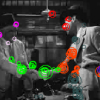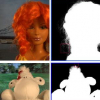101
Voted
CVPR
2010
IEEE
15 years 9 months ago
2010
IEEE
Detecting an object part relies on two sources of information - the appearance of the part itself, and the context supplied by surrounding parts. In this paper we consider problem...
CVPR
2010
IEEE
15 years 9 months ago
2010
IEEE
Modern structure from motion techniques are capable of building city-scale 3D reconstructions from large image collections, but have mostly ignored the problem of largescale struc...
104
click to vote
CVPR
2010
IEEE
15 years 9 months ago
2010
IEEE
To detect multiple objects of interest, the methods based on Hough transform use non-maxima supression or mode seeking in order to locate and to distinguish peaks in Hough images....
115
click to vote
CVPR
2010
IEEE
15 years 9 months ago
2010
IEEE
Based on multifractal analysis in wavelet pyramids of texture images, a new texture descriptor is proposed in this paper that implicitly combines information from both spatial and...
117
click to vote
CVPR
2010
IEEE
15 years 9 months ago
2010
IEEE
Blur from camera shake is mostly due to the 3D rotation of the camera, resulting in a blur kernel that can be significantly non-uniform across the image. However, most current de...
CVPR
2010
IEEE
15 years 9 months ago
2010
IEEE
Repetitive and ambiguous visual structures in general pose a severe problem in many computer vision applications. Identification of incorrect geometric relations between images s...
112
click to vote
CVPR
2010
IEEE
15 years 9 months ago
2010
IEEE
Multiplexing is a common technique for encoding highdimensional image data into a single, two-dimensional image. Examples of spatial multiplexing include Bayer patterns to capture...
CVPR
2010
IEEE
15 years 9 months ago
2010
IEEE
We present a novel approach to the causal temporal analysis of event data from video content. Our key observation is that the sequence of visual words produced by a space-time dic...
114
click to vote
CVPR
2010
IEEE
15 years 9 months ago
2010
IEEE
Image matting is of great importance in both computer vision and graphics applications. Most existing state-of-the-art techniques rely on large sparse matrices such as the matting ...
CVPR
2010
IEEE
15 years 9 months ago
2010
IEEE
We present a novel approach to address the representation issue and the matching issue in face recognition (verification). Firstly, our approach encodes the micro-structures of t...


